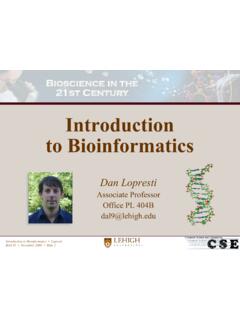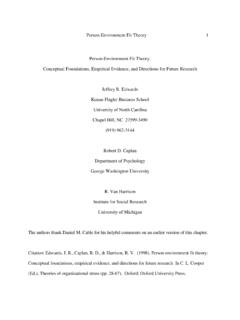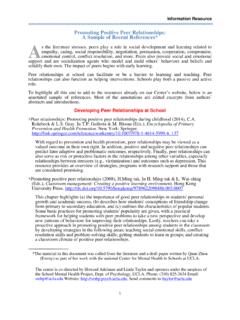Transcription of How Does the Environment Affect the Person?
1 How Does the Environment Affect thePerson?Mark H. BickhardHow Does the Environment Affect the Person? Mark H. Bickhard invited chapter in Children's Developmentwithin Social Contexts: Metatheoretical, Theoreticaland Methodological Issues, by L. T. Winegar, J. Valsiner, in Does the Environment Affect the Person? Mark H. BickhardAbstractStandard conceptions of how the Environment influences the person areconstrained by the dominant view of representation - and, therefore, perception,cognition, and language - as fundamentally consisting of encodings. I arguethat this encoding view is logically incoherent. An alternative view ofrepresentation is presented, interactivism, and shown to avoid theincoherencies of encodingism. The interactivist model of representationprovides accounts for standard presumed encoding phenomena, and highlightsprocesses and forms of influence of the Environment on the person that areobscure or entirely absent from the encoding account.
2 The multiplicity andcomplexity of the processes of environmental influence acquire a theoreticallycoherent organization and development from within the interactive Does the Environment Affect the Person? Mark H. BickhardIntroductionIt is generally assumed that human beings perceive and understand theworld through the senses, and that that epistemic connection with the worldoccurs via the transmission of information from the world through those sensesinto a mind. The converse perspective on this same assumption is that theenvironment influences individuals, both microgenetically and developmentally,via the information that is generated in that Environment and transmitted into theminds of those individuals. I wish to contest this standard view of the nature ofepistemic contact with the world, and, therefore, also contest the correspondingstandard view of how the Environment influences behavior and quick sense that there might be something wrong with both sides of thestandard view can be derived from consideration of what is usually taken to bea purely philosophical problem with purely philosophical consequences: theproblem of skepticism (Annas & Barnes, 1985; Burnyeat, 1983; Popkin, 1979;Rescher, 1980; Stroud, 1984; Wittgenstein, 1969).
3 Briefly stated, the problem ofskepticism arises from the question: How can we possibly know that ourrepresentations of the world are correct? The only answer seems to involvechecking those representations against the world to see if they in fact match,but, by assumption, the only epistemic contact we have with the world is viathose representations themselves - any such check, therefore, is circular andprovides no epistemic is generally relegated to philosophy, and, althoughphilosophers periodically attempt to discredit the skeptical question, no one hasin fact succeeded in solving it. The consensus, however, is that there has to besomething wrong with the skeptic's position, since it is clear that we do in facthave epistemic knowledge of the world. This presumed invalidation of thequestion, and, therefore, of the problem, is presupposed with even greater forcein psychology - not only must there be something wrong with the question thatseems to pose the problem, but it's all just philosophizing anyway and has norelevance to the business of , psychology is, among other things, in the business oftrying to understand epistemic relationships between individuals and the world,and of addressing other relationships that often make strong presuppositionsconcerning the fact and the nature of such epistemic relationships.
4 Even if weaccept the fact of such epistemic contact between the individual and the world,our models and our presuppositions commit us to particular conceptions of thenature of that epistemic contact: the simple rejection of the skeptical conclusionthat we do not have any such epistemic contact does not suffice to invalidate therelevance of the skeptical argument to psychology. In particular, if the standardpresuppositions concerning the nature of those epistemic relationships are in2fact vulnerable to the skeptic's argument, and if the argument is not invalid initself, then the entire body of work which involves those presuppositions isinvalidated. I will argue 1) that the skeptic's problem is one of a class of relatedproblems, all of which are valid and fundamental to the epistemologicalenterprise, 2) that contemporary approaches to epistemology - of, for example,perception, cognition, language, or sociality - are intrinsically incapable ofsolving or of dissolving these problems, and 3) that, therefore, approaches thatmake standard presuppositions concerning these epistemological issues - suchas contemporary approaches to understanding the influence of the environmenton the behavior and development of the individual - are similarly invalidated.
5 Ithen wish to outline an approach that is not vulnerable to the general class ofproblems that includes the skeptic's problem, and to explore some of theconsequences of this approach to the general problem of the influence of theenvironment on behavior and Impossibility of EncodingismThe "transmission of information" model rests upon a general view of thenature of representation: a view of representation as consisting fundamentallyof encodings. In this view, 'information' is encoded, transmitted, decoded, andnew encodings are generated on the inferential or heuristic basis of otheralready extant encodings. In other words, information is transmitted - andprocessed and understood - in the form of encoding representations. Myrejection of this view rests on a rejection of the encodingist model ofrepresentation: if representation is not fundamentally constituted as encodings,then the transmission view cannot be sustained, and must be changed inunforeseeable ways to accommodate the non-encoding character ofrepresentation, whatever that may be.
6 I begin, then, with a characterization ofencodingism, followed by a further elaboration of its critiques, an alternativemodel of representation, and an exploration of some equivalent characterizations of encodings will be outlined:encodings as representational stand-ins; encodings as representations definedin terms of what they represent; and encodings as known correspondences withwhat they represent. The stand-in perspective on encodings is clearest andmost paradigmatic. It captures directly the character of such encodings asMorse code or computer code. The basic notion is that an encoding stands-infor some other representation, as, for example, ".." stands-in for "S" in Morsecode, or equivalently for some bit pattern in a computer. Such stand-ins changethe form of representation, and thereby allow things to be done with and torepresentations that would otherwise be impossible or difficult: ".
7 " can be sentover a telegraph wire, while "S" cannot, and the potentialities of bit patterns incomputers are myriad. The stand-in relationship can also be defined withrespect to combinations of other representations, creating, in effect, encodingabbreviations. The critical point for my current purposes is to note thatencodings as stand-ins require that the representation(s) that are to be stood-in-for must be already present for the stand-in encoding to be definable. Stand-inencodings only change the form of representation, they do not and cannotcreate new representations (except in the sense of new combinations ofrepresentations already present).3 The second characterization of encodings is as representationalelements defined in terms of what they represent. This is manifested instandard manners of speech such as "This thing, X say, represents (encodes)Y" where "Y" specifies what "X" is to represent.
8 This is, in fact, the manner inwhich most encodings are introduced - they are defined as encodings byspecifying what they are to be taken as representing. This view of encodings,however, is just a different perspective on encodings as stand-ins. The definedencoding stands-in for whatever is used to specify what it represents: "X" standsin for "Y". In other words, to define "'X' represents Y" requires that "X" bealready known, that "Y" be already known, and that what "Y" represents bealready known so that "X" can be used to represent the same thing as "Y" - sothat "X" can stand-in for "Y".Encodings as known correspondences is still a third perspective. "X"encodes Y involves an epistemic correspondence between "X" and Y that isknown to whatever epistemic agent is able to take "X" as an encoding of epistemic correspondences can be arbitrarily defined between any "X"and any Y, or the epistemic definition can be based on already existing factual,perhaps even lawful, relationships between "X" and Y.
9 In order to know thecorrespondence, in order to be able to take "X" as an encoding for Y, whetherarbitrary or not, an epistemic agent has to already know both "X" and Y and,perhaps, the non-arbitrary non-epistemic (factual or lawful) relationshipbetween them. In knowing this relationship and what the relationship is with,specification of what the relationship is with must itself occur in terms of somerepresentation or another, some "Y", and, with respect to that specifyingrepresentation, "X" is again a stand-in. All three views of encodings, then, areequivalent: they are just differing perspectives on one underlying form ofepistemic correspondence view, however, can be particularly misleading. It isoften tempting to consider factual or lawful correspondences to constituteencodings - to constitute epistemic relationships - without explicit considerationof what the relevant epistemic agent is or how it could possibly know of thecorrespondence at all or what the correspondence is a correspondence activity in the retina, for example, is generally in factual correspondencewith various properties of the light, and this is labelled an encoding of thoseproperties of the light.
10 DNA base pair triples selectively correspond to particularamino acids in protein construction, and this too is labelled an encodingrelationship. Yet, there is no agent in the retina, or neural tract, that knowsanything about those light properties. Human beings and other animals havebeen seeing their environments for millions of years without knowing anythingat all about light properties per se. Nevertheless, the encoding story - thesensory transduction story - is the standard account of vision and other sensoryprocesses (Carlson, 1986).Transduction, in its basic meaning, refers to a transformation of form ofenergy. Such a transformation will, in general, yield a factual correspondencebetween the two forms of energy and the events associated with them. Tosimply assume that this factual correspondence constitutes an epistemiccorrespondence, as in transduction models of sensory processes, is not only a4non-sequitur, the incoherence problem shows that it is impossible to validly fillin the , DNA base pair triples exert specific effects in a complicatedprocess of protein construction, effects that do in fact differentiate particularamino acids, and, thus, establish a factual correspondence with those aminoacids.















